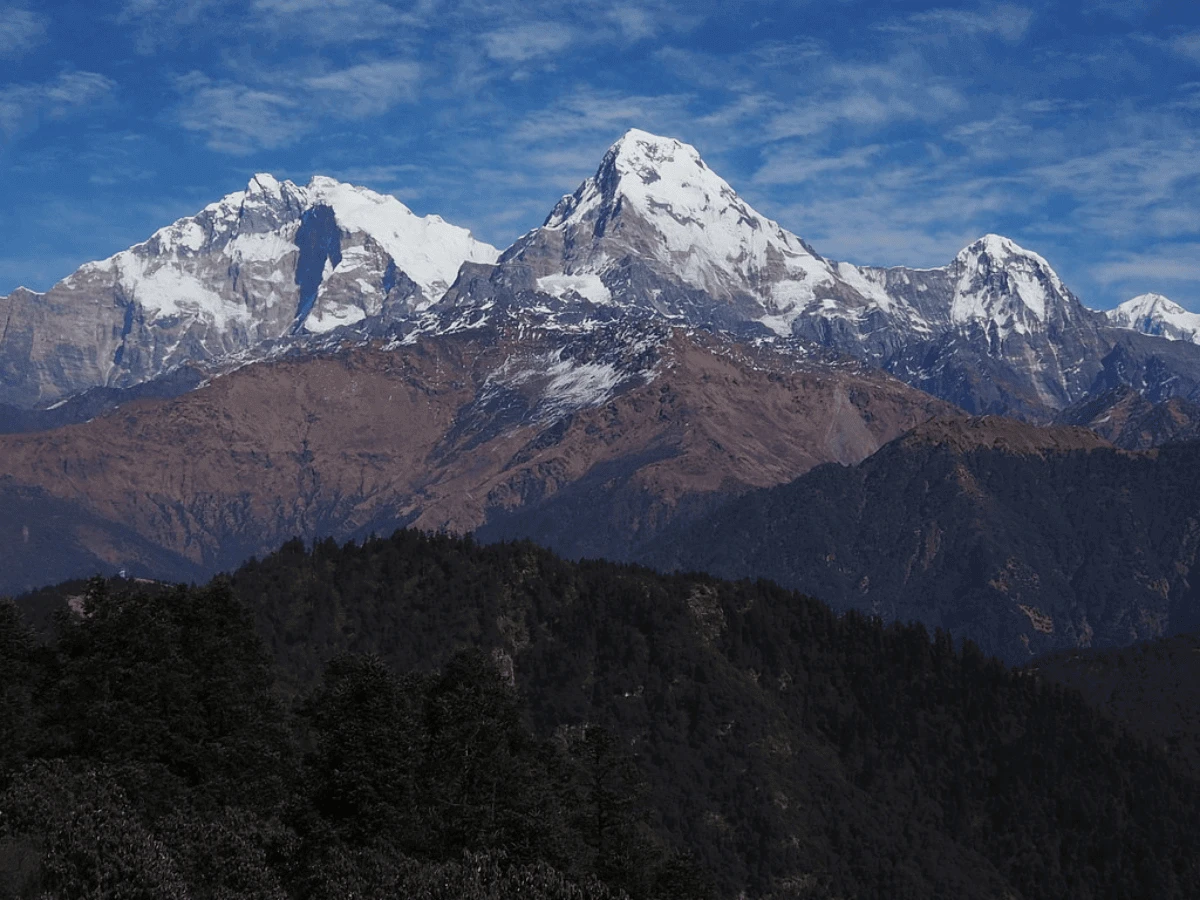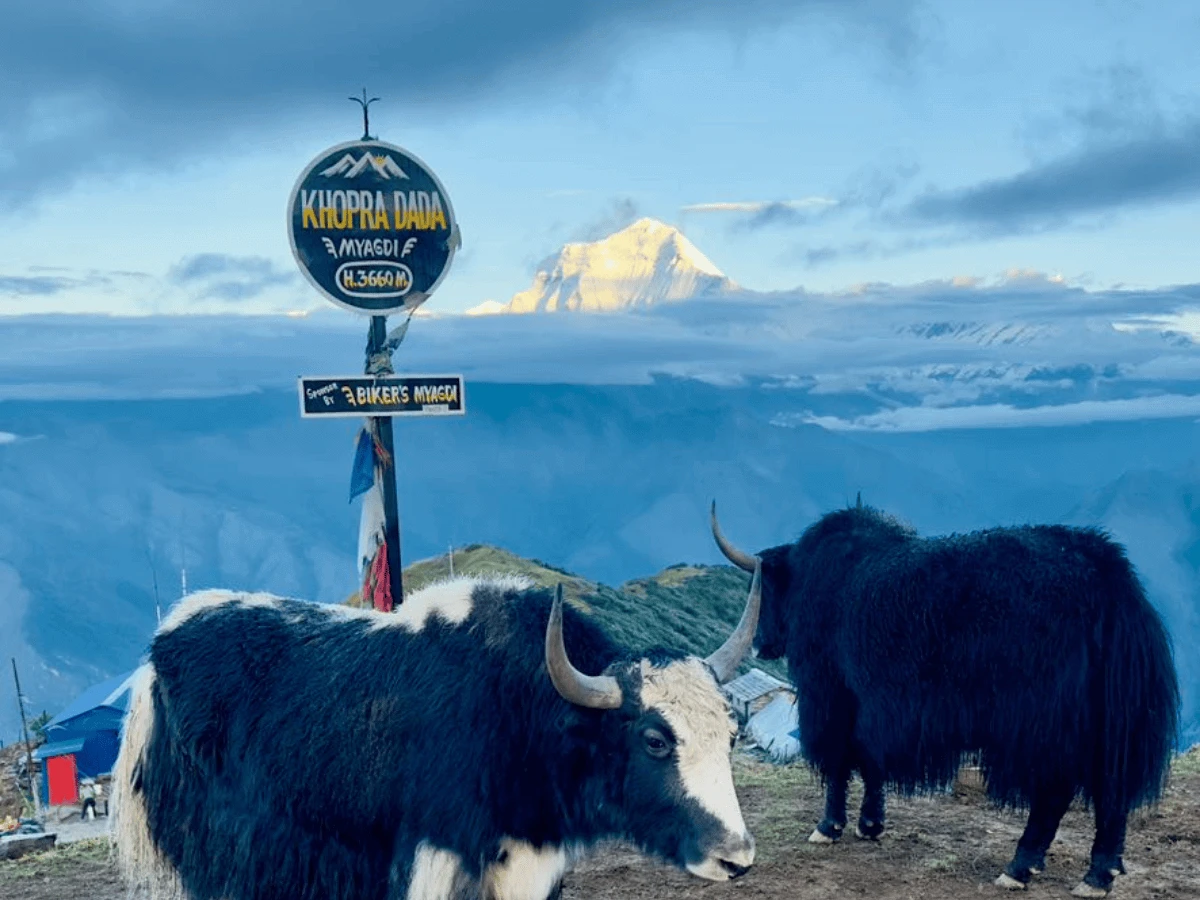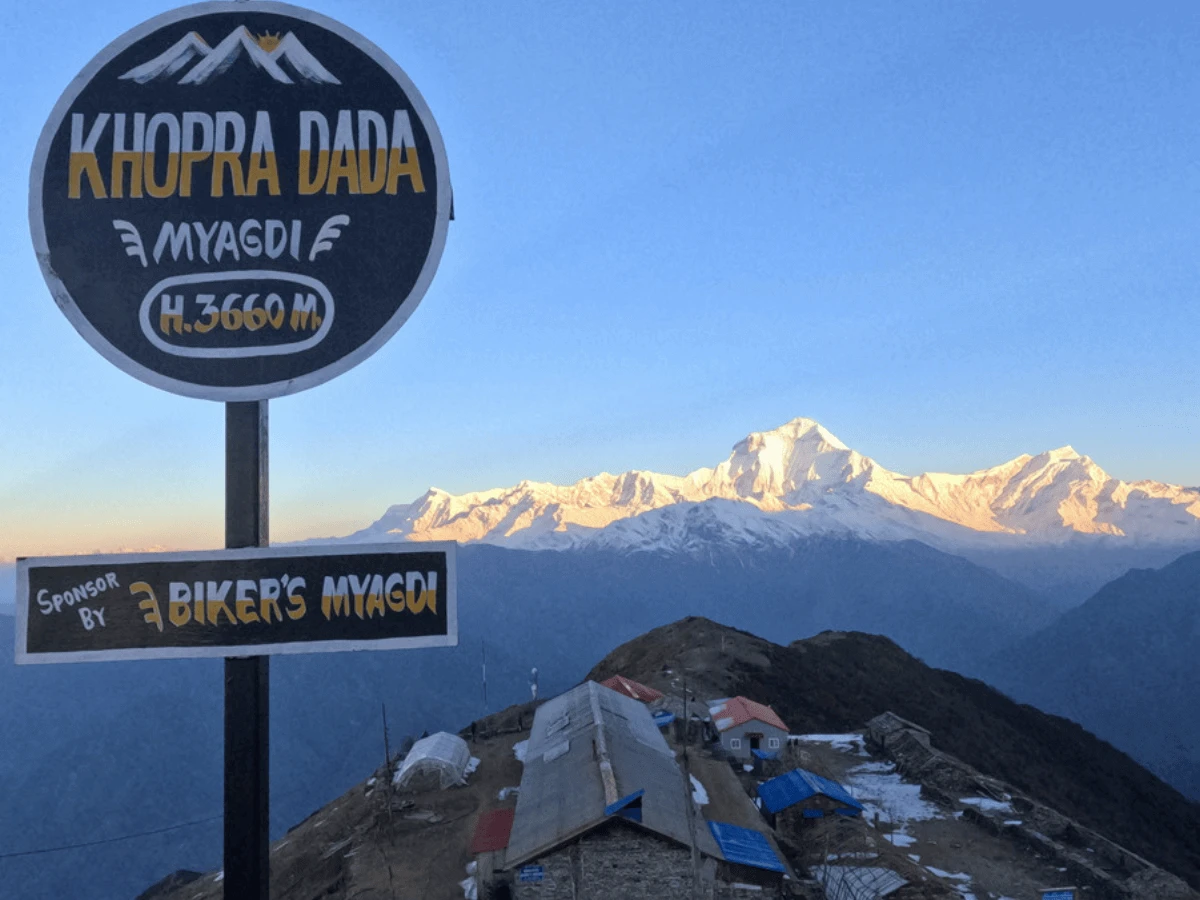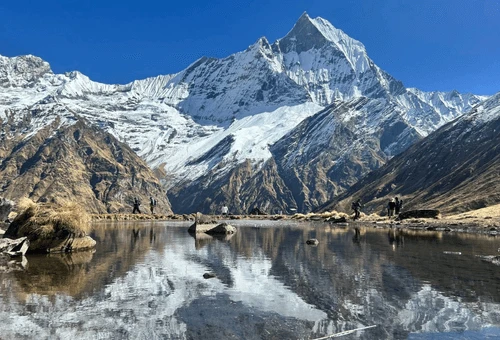The Khopra Danda Trek is especially famous for the optional hike to Khayer Lake – a high-altitude holy lake tucked beneath Annapurna South at about 4,660 m. The trek’s pinnacle is reaching Khopra Danda (Khopra Ridge) itself at 3,660 m. Moreover, the journey offers a splendid blend of scenic mountain vistas, rich local culture, and tranquil trails away from the usual crowds.
Witness the Himalaya Ranges, like Dhaulagiri (8167 m) and Annapurna I (8091 m), which offer immersive walks through rhododendron forests, and visits to traditional Gurung and Magar villages are the highlights of this trek.
Despite being relatively close to popular routes like the Ghorepani-Poon Hill Trek and Annapurna Base Camp trek, the Khopra Danda Trek remains a quieter, community lodge-based trek run by local communities, making it a hidden gem for seasoned adventurers seeking authenticity and tranquillity.
What makes Khopra Danda special is its relative solitude and community-run lodges. Unlike the busy teahouses on the main Annapurna trail, the Khopra Community Lodge on the ridge is managed by local villagers, with proceeds supporting the community. This not only gives you a warm, homely hospitality but also means your visit contributes to local development – a win-win for eco-tourism.
Khopra Danda Trek with Khayer Lake Hile
A highlight of this trek is the day hike to Khayer Lake. The Lake is considered sacred by Hindu and Buddhist pilgrims. Hindu Devotees believe that bathing in its icy waters during the Janai Purnima festival grants spiritual merit.
The hike from Khopra Danda to Khayer Lake is challenging, 5–6 hours one way on a steep trail, with the trek’s highest point at around 4,660 m. This hike to Khayer Lake is rewarded with serene alpine landscapes. After soaking in the tranquillity of Khayer Lake, you’ll return to Khopra Danda for the night.
What to Anticipate During the Trek to Khopra Ridge
The Khopra Ridge trek is a moderate-grade trek of 10-12 days, depending on the starting point. You must be prepared to walk for at least 5-6 hours along the stone staircases and forest paths to narrow mountain trails. The route ascends gradually, allowing for acclimatisation, with the highest sleeping elevation at Khopra Danda (3,660 m). The trail is well-defined but far less travelled than routes like Annapurna Base Camp, so expect peaceful, uncrowded paths.
Moreover, the Khopra Danda Trek leads you through several traditional Gurung and Magar villages, where you can experience the local way of life firsthand.
From the stone-flagged lanes of Ghandruk (a large Gurung village with a museum) to the farming community of Swanta, you’ll witness daily routines of herding, farming, and perhaps partake in some cultural exchanges.
Embark on the Poon Hill Hike Before Trekking to Khopra Danda
No trek in the Annapurna region would be complete without the famed Poon Hill sunrise. The Khopra Danda Trek allows you to hike to Poon Hill (3210 m) for the sunrise views over the Annapurna and Dhaulagiri Ranges.
Many Khopra itineraries begin or end with the Poon Hill Trek, but our recommended route hits it before heading deeper towards Khopra. By doing the Poon Hill Trek as part of your Khopra Danda Trek, you effectively combine two epic experiences: a classic Ghorepani-Poon Hill trek segment and the off-beat Khopra Ridge journey. This combo is highly recommended for trekkers who want maximum views in a short timeframe.
Khopra Danda Trek Route
The Khopra Danda Trek route forms a loop in the Annapurna region, and it can be done through two routes. However, our Khopda Danda Trek Itinerary is carefully designed so that it will be easy for our clients to achieve it without any difficulties.
The Khopra Danda Trek Route starts with the drive from Pokhara to Birethanti and follows the Ghorepani Poon Hill Trail. After enjoying Poon Hill, the route diverges southward to Swanta. From Swanta, you continue to Chistibang – a small pasture settlement – and then ascend to Khopra Danda (3660 m). Khopra Danda is typically the farthest point of the loop and the highest overnight stop.
After Khopra, the trail turns back eastward and then north to rejoin the main Annapurna trail. You descend via Bayeli Kharka (3450 m) to Tadapani (2620 m), a familiar stop on the Annapurna Base Camp circuit. From Tadapani, you head down to Ghandruk (1940 m), a large Gurung village with road access. Finally, a drive (jeep or bus) takes you from Ghandruk or nearby Kimche back to Pokhara, completing the Khopra Danda Trek 10 Days.
Explore Khopra Danda Trek from Pokhara in 6 Days
If you’re short on time, it’s possible to complete the Khopra Danda Trek in about 6 days from Pokhara. Keep in mind that a 6-day version often means skipping Khayer Lake or Poon Hill Trek. Here’s an overview of how a 6-day Pokhara-to-Pokhara Khopra Ridge Trek might look:
Day 1: Drive from Pokhara to Ghandruk and Trek to Tadhapani
Day 2: Trek from Tadapani to Bayeli Kharka (3450 m)
Day 3: Trek from Bayeli to Khopra Danda (3660 m)
Day 4: (Optional) If you have the energy and an extra day, you can attempt Khayer Lake and return
Day 5: Trek from Swanta to Ghorepani (2860 m)
Day 6: Early morning hike to Poon Hill (3210 m) and Trek down to Nayapul and drive back to Pokhara
How Much Does the Khopra Danda Trek Cost in 2026,2027?
The Khopra Danda Trek cost can vary widely based on your trekking style, the duration, and the level of service you prefer. Below, we break down the main cost components and give rough estimates to help you budget. If you book an all-inclusive package, the cost for a 10–12 day Khopra Danda Trek (Kathmandu to Kathmandu) typically ranges from about $700 to $1200 USD per person. The price depends on group size and what’s included.
Mountain Eco Trails lists prices around $700 for a group of 4–5, up to about $850 for a solo trekker on a week-long Khopra trek. Need to know more details about the Khopra Danda Trek cost? Then feel free to contact us via email or WhatsApp at +9779849790153.
Why choose Mountain Eco Trails for the Khopra Trek?
Mountain Eco Trails has crafted this Khopra Danda Trek 10 Days for those who want to discover the Annapurna Himalayas within 10 Days. If the itinerary and the plan we have crafted don’t meet your requirements, feel free to contact our planner at WhatsApp at +9779849701053. When you book a trek with us, you have several benefits and are provided with safety. Here are the benefits of booking this trek with us:
- Complimentary Airport pick-up and drop-off.
- An experienced trekking guide who knows the trail like a home.
- Hassle-free last-minute booking and trek arrangements.
- Trekking Poles, Duffel Bag, and SIM card if needed.
- First Aid Kid carried by the trekking Guide.
- Regular communication with the trekking leader during the trek.
- A complimentary farewell dinner before departing from Nepal.




.webp)

